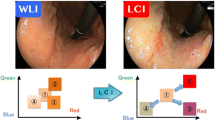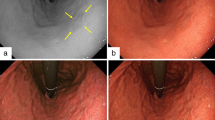Abstract
Background
In Japan, laser light source (Laser) endoscopy is widely available, and the characteristics of light-emitting diode light source (LED) endoscopy have not been clarified.
Aims
We assessed the visibility of early gastric cancers (EGCs) and Helicobacter pylori (H. pylori)-associated gastritis for LED endoscopy compared with laser endoscopy using white-light imaging (WLI) and linked color imaging (LCI).
Methods
We assessed 99 lesions between February 2019 and March 2020. The visibility was scored from four (excellent visibility) to one (poor visibility) by evaluating videos including EGCs and gastric mucosa captured using WLI and LCI with LED endoscopy (LED-WLI and LED-LCI, respectively) and laser endoscopy (Laser-WLI and Laser-LCI, respectively). The primary end point was the non-inferiority of the visibility of EGCs and H. pylori-associated gastritis between LED-/Laser-WLI and LED-/Laser-LCI.
Results
The visibility scores of EGCs for LED-/Laser-WLI and LED-/Laser-LCI were 3.14/2.97 and 3.39/3.35, respectively. The visibility scores of H. pylori-associated gastritis [intestinal metaplasia (IM), diffuse redness (DR), regular arrangement of collecting venules (RAC) and map-like redness (MR)] for LED-/Laser-WLI and LED-/Laser-LCI were 3.05/2.85 and 3.60/3.50 (IM), 2.76/2.50 and 2.96/2.86 (DR), 2.69/2.44 and 2.77/2.62 (RAC) and 2.97/2.75 and 3.39/3.27 (MR). Non-inferiority was demonstrated for visualizing EGCs and H. pylori-associated gastritis.
Conclusions
LED-WLI and LED-LCI can be used to visualize EGCs and H. pylori-associated gastritis with non-inferiority to Laser-WLI and Laser-LCI. Furthermore, even with LED, LCI was more effective than WLI for evaluating EGCs and H. pylori-associated gastritis. Therefore, LED endoscopy can be used to detect EGCs and evaluate H. pylori-associated gastritis accurately.




Similar content being viewed by others
References
Uemura N, Okamoto S, Yamamoto S et al. Helicobacter pylori infection and the development of gastric cancer. N Engl J Med. 2001;345:784–789.
Masuyama H, Yoshitake N, Sasai T et al. Relationship between the degree of endoscopic atrophy of the gastric mucosa and carcinogenic risk. Digestion. 2015;91:30–36.
Spence AD, Cardwell CR, McMenamin Ú et al. Adenocarcinoma risk in gastric atrophy and intestinal metaplasia: a systematic review. BMC Gastroenterol. 2017;17:157.
Sugano K, Tack J, Kuipers EJ et al. Kyoto global consensus report on Helicobacter pylori gastritis. Gut. 2015;64:1353–1367.
Sugimoto M, Ban H, Ichikawa H et al. Efficacy of the Kyoto Classification of Gastritis in Identifying Patients at High Risk for Gastric Cancer. Intern Med. 2017;56:579–586.
Yoshii S, Mabe K, Watano K et al. Validity of endoscopic features for the diagnosis of Helicobacter pylori infection status based on the Kyoto classification of gastritis. Dig Endosc. 2020;32:74–83.
Dohi O, Majima A, Naito Y et al. Can image-enhanced endoscopy improve the diagnosis of Kyoto classification of gastritis in the clinical setting? Dig Endosc. 2020;32:191–203.
Ono S, Dohi O, Yagi N et al. Accuracies of Endoscopic Diagnosis of Helicobacter pylori-Gastritis: Multicenter Prospective Study Using White Light Imaging and Linked Color Imaging. Digestion. 2020;101:624–630.
Takeda T, Asaoka D, Nojiri S et al. Linked Color Imaging and the Kyoto Classification of Gastritis: Evaluation of Visibility and Inter-Rater Reliability. Digestion. 2020;101:598–607.
Kaneko K, Oono Y, Yano T et al. Effect of novel bright image enhanced endoscopy using blue laser imaging (BLI). Endosc Int Open. 2014;2:E212–E219.
Fukuda H, Miura Y, Hayashi Y et al. Linked color imaging technology facilitates early detection of flat gastric cancers. Clin J Gastroenterol. 2015;8:385–389.
Yoshifuku Y, Sanomura Y, Oka S et al. Evaluation of the visibility of early gastric cancer using linked color imaging and blue laser imaging. BMC Gastroenterol. 2017;17:150.
Dohi O, Yagi N, Naito Y et al. Blue laser imaging-bright improves the real-time detection rate of early gastric cancer: a randomized controlled study. Gastrointest Endosc. 2010;89:47–57.
Gao J, Zhang X, Meng Q et al. Linked color imaging can improve detection rate of early gastric cancer in a high-risk population: a multi-center randomized controlled clinical trial. Dig Dis Sci. 2021;66:1212–1219.
Ono S, Kawada K, Dohi O et al. Linked Color Imaging Focused on Neoplasm Detection in the Upper Gastrointestinal Tract: A Randomized Trial. Ann Intern Med. 2021;174:18–24. https://doi.org/10.7326/M19-2561 (Epub 2020 Oct 20).
Majima A, Dohi O, Takayama S et al. Linked color imaging identifies important risk factors associated with gastric cancer after successful eradication of Helicobacter pylori. Gastrointest Endosc. 2019;90:763–769.
Yoshida N, Dohi O, Inoue K et al. Blue Laser Imaging, Blue Light Imaging, and Linked Color Imaging for the Detection and Characterization of Colorectal Tumors. Gut Liver. 2019;13:140–148.
Japanese gastric cancer treatment guidelines 2014 (ver. 4). Gastric Cancer. 2017;20:1–19.
Yoshida N, Hisabe T, Hirose R et al. Improvement in the visibility of colorectal polyps by using blue laser imaging (with video). Gastrointest Endosc. 2015;82:542–549.
Suzuki T, Hara T, Kitagawa Y et al. Linked-color imaging improves endoscopic visibility of colorectal nongranular flat lesions. Gastrointest Endosc. 2017;86:692–697.
Kitagawa Y, Suzuki T, Hara T et al. Linked color imaging improves the endoscopic visibility of gastric mucosal cancers. Endosc Int Open. 2019;7:E164–E170.
Kitagawa Y, Suzuki T, Nankinzan R et al. Comparison of endoscopic visibility and miss rate for early gastric cancers after Helicobacter pylori eradication with white-light imaging versus linked color imaging. Dig Endosc. 2020;32:769–777. https://doi.org/10.1111/den.13585 (Epub 2019 Dec 26).
Gwet KL. Computing inter-rater reliability and its variance in the presence of high agreement. Br J Math Stat Psychol. 2008;61:29–48.
Yoshida N, Naito Y, Yasuda R et al. Linked color imaging improves the visibility of various featured colorectal polyps in an endoscopist’s visibility and color difference value. Int J Colorectal Dis. 2017;32:1253–1260.
Takayama S, Dohi O, Naito Y et al. Diagnostic ability of magnifying blue light imaging with a light emitting diode light source for early gastric cancer: a prospective comparative study. Digestion. 2021;102:580–589.
Acknowledgments
We thank all members of the Department of Molecular Gastroenterology and Hepatology, Graduate School of Medical Science, Kyoto Prefectural University of Medicine, for helping us perform this study.
Author information
Authors and Affiliations
Corresponding author
Ethics declarations
Conflict of interest
Osamu Dohi received a research grant from Fujifilm Co., Ltd. (J192001048 and J192001259). Naohisa Yoshida received a research grant from Fujifilm Co., Ltd. (J162001222). The other authors have no conflicts of interest to declare. Fujifilm Co., Ltd., had no role in the design, conduct, data collection, data interpretation or reporting of this study.
Additional information
Publisher's Note
Springer Nature remains neutral with regard to jurisdictional claims in published maps and institutional affiliations.
An editorial commenting on this article is available at https://doi.org/10.1007/s10620-021-07235-4.
Rights and permissions
About this article
Cite this article
Ishida, T., Dohi, O., Yoshida, N. et al. Enhanced Visibility in Evaluating Gastric Cancer and Helicobacter pylori-Associated Gastritis Using Linked Color Imaging with a Light-Emitting Diode Light Source. Dig Dis Sci 67, 2367–2374 (2022). https://doi.org/10.1007/s10620-021-07234-5
Received:
Accepted:
Published:
Issue Date:
DOI: https://doi.org/10.1007/s10620-021-07234-5




